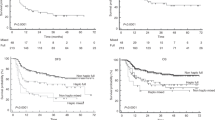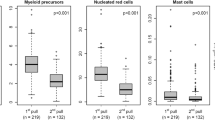Abstract
Tumor contamination of autologous peripheral blood stem/progenitor cell grafts occurs in a substantial proportion of high-risk breast cancer patients, and the possibility that such contamination may contribute to relapse has focused attention on methods for removal of the contaminating cells prior to transplantation. One such approach is positive selection of CD34+ cells. A fully automated immunomagnetic cell selection system has recently been introduced to facilitate the positive selection process. A multicenter randomized clinical trial was designed to evaluate the capacity of CD34+ cells isolated using the fully automated system to support prompt hematopoietic reconstitution following high-dose chemotherapy in high-risk breast cancer patients, as well as to assess the safety and tolerability of the CD34+ cell transplants. In recipients of isolated CD34+ cells, the median time to an absolute neutrophil count ⩾500/μl was 10 days, a value identical to that observed in patients receiving unfractionated apheresis collections. In the isolated CD34+ cell recipients median time to a platelet count ⩾20 000/μl was 12 days, compared with 10 days in the unfractionated cell group. There were no statistically significant differences between the groups in median time to neutrophil or platelet engraftment. Infusion of autologous cells was well tolerated by the study groups. There were no inter-group differences in the incidence of infections, need for platelet transfusions, or duration of hospitalization. Isolated CD34+ cells were high in purity and sufficient in number for use in autologous transplantation. The fully automated immunomagnetic cell selection system affords an efficient and time-saving option for isolation of CD34+cells to be used as autologous grafts in high-risk breast cancer patients, and the isolated CD34+ cells support undelayed hematopoietic reconstitution. Bone Marrow Transplantation (2000) 25, 1165–1174.
This is a preview of subscription content, access via your institution
Access options
Subscribe to this journal
Receive 12 print issues and online access
$259.00 per year
only $21.58 per issue
Buy this article
- Purchase on Springer Link
- Instant access to full article PDF
Prices may be subject to local taxes which are calculated during checkout





Similar content being viewed by others
References
Bearman SI, Shpall EJ, Jones RB et al. High-dose chemotherapy with autologous hematopoietic progenitor cell support for metastatic and high-risk primary breast cancer Semin Oncol 1996 23: 60–67
Antman KH, Rowlings PA, Vaughan WP et al. High-dose chemotherapy with autologous hematopoietic stem-cell support for breast cancer in North America J Clin Oncol 1997 15: 1870–1879
Hortobagyi GN, Buzdar AU, Champlin R et al. Lack of efficacy of adjuvant high-dose (HD) tandem combination chemotherapy (CT) for high-risk primary breast cancer (HRPBC)-a randomized trial Proc Am Soc Clin Oncol 1998 17: 12
Rodenhuis S, Richel DJ, van der Wall E et al. Randomised trial of high-dose chemotherapy and haemopoietic progenitor-cell support in operable breast cancer with extensive axillary lymph-node involvement Lancet 1998 352: 515–521
Bergh J, . ScandinavianBreastCancerStudyGroup9401 Results from a randomized adjuvant breast cancer study with high dose chemotherapy with CTCb supported by autologous bone marrow stem cells versus dose escalated and tailored FEC therapy Proc Am Soc Clin Oncol 1999 18: 2A
Bezwoda WR . Randomised, controlled trial of high dose chemotherapy (HD-CNVp) vs. standard dose (CAF) chemotherapy for high risk, surgically treated, primary breast cancer Proc Am Soc Clin Oncol 1999 18: 2A
Peters WP, Rosner G, Vredenburgh J et al. A prospective, randomized comparison of two doses of combination alkyating agents (AA) as consolidation after CAF in high-risk primary breast cancer involving ten or more axillary lymph nodes (LN): preliminary results of CALGB 9082/SWOG 9114/NCIC MA-13 Proc Am Soc Clin Oncol 1999 18: 1A
Bezwoda WR, Seymour L, Dansey RD . High-dose chemotherapy with hematopoietic rescue as primary treatment for metastatic breast cancer: a randomized trial J Clin Oncol 1995 13: 2483–2489
Peters WP, Jones RB, Vredenburgh J et al. A large, prospective, randomized trial of high-dose combination alkylating agents (CPB) with autologous cellular support (ABMS) as consolidation for patients with metastatic breast cancer achieving complete remission after intensive doxorubicin-based induction therapy (AFM) Proc Am Soc Clin Oncol 1996 15: A149
Lotz JP, Cure H, Janvier M et al. High-dose chemotherapy (HD-CT) with hematopoietic stem cells transplantation (HSCT) for metastatic breast cancer (MBC): results of the french protocol PEGASE 04 Proc Am Soc Clin Oncol 1999 18: 43A
Stadtmauer EA, O'Neill A, Goldstein LJ et al. Phase III randomized trial of high-dose chemotherapy (HDC) and stem cell support (SCT) shows no difference in overall survival or severe toxicity compared to maintenance chemotherapy with cyclophosphamide, methotrexate and 5-fluorouracil (CMF) for women with metastatic breast cancer who are responding to conventional induction chemotherapy: the ‘Philadelphia’ Intergroup Study (BPT-1) Proc Am Soc Clin Oncol 1999 18: 1A
Antman KH, Heitjan DF, Hortobagyi GN . High-dose chemotherapy for breast cancer JAMA 1999 282: 1701–1703
Sharp JG, Kessinger A, Vaughan WP et al. Detection and clinical significance of minimal tumor contamination of peripheral stem cell harvests Int J Cell Cloning 1992 10: 92–94
Ross AA, Cooper BW, Lazarus HM et al. Detection and viability of tumor cells in peripheral blood stem cell collections from breast cancer patients using immunocytochemical and clonogenic assay techniques Blood 1993 82: 2605–2610
Passos-Coelho J, Ross AA, Davis JM et al. Bone marrow micrometastases in chemotherapy-responsive advanced breast cancer: effect of ex vivo purging with 4-hydroperoxycyclophosphamide Cancer Res 1994 54: 2366–2371
Shpall EJ, Jones RB, Bearman SI et al. Transplantation of enriched CD34-positive autologous marrow into breast cancer patients following high-dose chemotherapy: influence of CD34-positive peripheral-blood progenitors and growth factors on engraftment J Clin Oncol 1994 12: 28–36
Simpson SJ, Vachula M, Kennedy MJ et al. Detection of tumor cells in the bone marrow, peripheral blood, and apheresis products of breast cancer patients using flow cytometry Exp Hematol 1995 23: 1062–1068
Brenner MK, Rill DR, Moen RC et al. Gene-marking to trace origin of relapse after autologous bone-marrow transplantation Lancet 1993 341: 85–86
Deisseroth AB, Zu Z, Claxton D et al. Genetic marking shows that Ph+ cells present in autologous transplants of chronic myelogenous leukemia (CML) contribute to relapse after autologous bone marrow in CML Blood 1994 83: 3068–3076
Rill DR, Santana VM, Roberts WM et al. Direct demonstration that autologous bone marrow transplantation for solid tumors can return a multiplicity of tumorigenic cells Blood 1994 84: 380–383
Shpall EJ, Gee AP, Hogan C et al. Bone marrow metastases Hematol Oncol Clin North Am 1996 10: 321–343
Krause DS, Fackler MJ, Civin CI, May WS . CD34: structure, biology and clinical utility Blood 1996 87: 1–13
Hohaus S, Pforsich M, Murea S et al. Immunomagnetic selection of CD34+ peripheral blood stem cells for autografting in patients with breast cancer Br J Haematol 1997 97: 881–888
Mapara MY, Korner IJ, Hildebrandt M et al. Monitoring of tumor cell purging after highly efficient immunomagnetic selection of CD34 cells from leukapheresis products in breast cancer patients: comparison of immunocytochemical tumor cell staining and reverse transcriptase-polymerase chain reaction Blood 1997 89: 337–344
Roots-Weiβ A, Papadimitriou C, Serve H et al. The efficiency of tumor cell purging using immunomagnetic CD34+ cell separation systems Bone Marrow Transplant 1997 19: 1239–1246
Strauss LC, Trischmann TM, Rowley SD et al. Selection of normal human hematopoietic stem cells for bone marrow transplantation using immunomagnetic microspheres and CD34 antibody Am J Pediatr Hematol Oncol 1991 13: 217–221
Hardwick A, Law P, Kulcinski D et al. Development of a large scale immunomagnetic separation system for harvesting CD34 cells from bone marrow Prog Clin Biol Res 1992 377: 583–589
Papadimitriou CA, Roots A, Koenigsmann M et al. Immunomagnetic selection of CD34+ cells from fresh peripheral blood mononuclear cell preparations using two different separation techniques J Hematother 1995 4: 539–544
Chabannon C, Cornetta K, Lotz J-P et al. High-dose chemotherapy followed by reinfusion of selected CD34+ peripheral blood cells in patients with poor-prognosis breast cancer: a randomized multicentre study Br J Cancer 1998 78: 913–921
Ishizawa L, Marvin S, Jain R et al. Fully automated CD34+ stem cell selection with integrated cell washing capabilities: performance evaluation Bone Marrow Transplant 1996 17: S129
Brockmeyer C, Deans R, Schwender J et al. CD34+ stem cells released during Isolex selection have membrane integrity with no residual cell surface antibody Blood 1996 88: 244b
Guillermo R, Helwich M, Schneidkraut MJ, Huntenburg CC . CD34+ cell selection using the Isolex 300SA: comparison of chymopapain and PR34+ processes Bone Marrow Transplant 1996 17: S128
Marolleau JP, Dal Cortivo L, Mills B et al. Enrichment of peripheral blood CD34+ cells for transplantation using a fully automated immunomagnetic cell selection system and a novel octapeptide releasing agent Bone Marrow Transplant 1999 23: 819–826
Burgess J, Mills B, Griffith M et al. Reduction of breast cancer cells in peripheral blood stem cell products by positive selection of CD34+ cells J Hematother 1998 7: 285
Burgess J, Mills B, Griffith M et al. Breast tumor contamination of peripheral blood stem cell harvests. II. Tumor depletion by positive selection of CD34+ cells. (Submitted)
Martino M, Morabito F, Messina G et al. Fractionated infusions of cryopreserved stem cells may prevent DMSO-induced major cardiac complications in graft recipients Haematologica 1996 81: 59–61
Zambelli A, Poggi G, Da Prada G et al. Clinical toxicity of cryopreserved circulating progenitor cells infusion Anticancer Res 1998 18: 4705–4708
Somlo G, Doroshow JH, Forman SJ et al. High-dose chemotherapy and stem-cell rescue in the treatment of high-risk breast cancer: prognostic indicators of progression-free and overall survival J Clin Oncol 1997 15: 2882–2893
Author information
Authors and Affiliations
Rights and permissions
About this article
Cite this article
Yanovich, S., Mitsky, P., Cornetta, K. et al. Transplantation of CD34+ peripheral blood cells selected using a fully automated immunomagnetic system in patients with high-risk breast cancer: results of a prospective randomized multicenter clinical trial. Bone Marrow Transplant 25, 1165–1174 (2000). https://doi.org/10.1038/sj.bmt.1702415
Received:
Accepted:
Published:
Issue Date:
DOI: https://doi.org/10.1038/sj.bmt.1702415
Keywords
This article is cited by
-
Mobilization, harvesting and selection of peripheral blood stem cells in patients with autoimmune diseases undergoing autologous hematopoietic stem cell transplantation
Bone Marrow Transplantation (2007)
-
Stem-cell transplantation for the treatment of advanced solid tumors
Springer Seminars in Immunopathology (2004)
-
Preclinical evaluation of an automated closed fluid management device: CytomateTM, for washing out DMSO from hematopoietic stem cell grafts after thawing
Bone Marrow Transplantation (2003)
-
Prognostic significance of the detection of tumour cells in peripheral blood stem cell collections in stage II and III breast cancer patients treated with high-dose therapy
Bone Marrow Transplantation (2003)
-
Occult tumor cell contamination in patients with stage II/III breast cancer receiving sequential high-dose chemotherapy
Bone Marrow Transplantation (2003)



